Printed in National Cactus and Succulent Journal, 37:31(1981).
Part 5. HAWORTHIA ANGUSTIFOLIA Haworth.
M. B. Bayer, National Botanic Gardens of South Africa, Karoo Gardens, Worcester.
Haworthia angustifolia was described by Haworth in Philosophical Magazine in 1825 as follows:- “(slender leaved) leaves lorate attenuate, curved, widely recurved, wholly green, apex nearly keeled, keel armed with small closely spaced teeth from point of emergence. Similar to H. chloracantha Haw., but smaller, leaves narrower, more recurved and longer, 3-4 inches long, convex below, flat above, soft elevated longitudinal lines in the middle, marginal teeth small and barely visible to the eye”.
Roemer and Schultes (in Systema Vegetabilium 7: 641, 1829) listed Aloe stenophylla based on Haworth’s H. angustifolia, and Salm-Dyck followed suit (Monographia, 13: f2, 1849). Salm-Dyck’s illustration shows also the proper flower of the subgenus Haworthia, and not that of Chortolirion stenophyllum (Baker) Berger. Baker did not cite a particular specimen when he redescribed H. angustifolia (in J. Linn. Soc. 18: 210, 1880) although his embroidered version may suggest that he did have plants available. Fourcade (in Trans. R. Soc. S. Afr. 21: 78, 1932) in fact considered Baker to have diverged so far from the original that he proposed the new name H. monticola for Baker’s species. Fourcade compared the Baker and Haworth concepts thus:- “H. angustifolia Haw.—leaves recurved, lineate, wholly green and (by virtue of inclusion in the section Reticulata) pellucid at the tips. H. monticola Fourc. (i.e. H. angustifolia Baker) – leaves, erect and straight or incurved (Baker wrote only ‘ascending’) not lineate, dark green above and translucent in the lower half. (Baker wrote ‘uniform pale green’)”.
Fourcade himself appears to have deviated from Baker’s description.
If Haworth’s original description is carefully studied (sic!) it is clear that Fourcade’s interpretation of ‘lineate’ and ‘pellucid’ is unacceptable.
Very relevant to the issue are the later descriptions of H. albanensis Schonland (1912), H. angustiflia var. paucifolia Smith, H. angustifolia var. grandis Smith, H. chloracantha var. subglauca v. PoelIn. (H. chloracantha var. subfalcata v. PoelIn.) and H. angustifolia var. lilliputana Uitewaal.
H. albanensis was described from Fernkloof Grahamstown and was stated to have smaller teeth on the leaves than H. chloracantha and H. angustifolia. It was also stated to differ from the former by virtue of having slightly shorter flowers and differently shaped leaves, and from the latter by the obtuse flower segments. H. angustifolia var. grandis and H. angustifolia var. paucifolia were both described from within a mile of each other east of Grahamstown. H. angustifolia var. lilliputana was described from Mossel Bay and H. chloracantha var. subglauca from Great Brak. Von Poellnitz associated the species name H. chloracantha with Great Brak, and the name H. angustifolia with Bredasdorp, Littlee Brak, Avontuur and Calitzdorp as well as Great Brak) mening that he confused it with chloracantha and with monticola). Smith similarly used the name H. angustifolia in his field notes for variants of H. magnifica v. Poelln. and H. reticulata Haw.
Fourcade’s reference to H. angustifolia sensu Baker from the Uniondale (and George) area can be related to von Poellnitz’ and Smith’s references to H. variegata from Uniondale and Willowmore, and it is reasonably certain that the species was actually H. divergens Bayer which occurs there. In attempting to understand this arrangement and ensure the correct usage of names, it is necessary to view the position in the field. It is also necessary to bear in mind the situation in Haworthia where the species are poorly defined both in terms of morphological and biological integrity. It is apparent that four main elements are involved. Firstly there is H. variegata Bol. from the coastal calcareous soils south-east of Riversdale, H. chloracantha Haw. in the Mossel Bay/Great Brak area, H. divergens Bayer in the Molen River, Uniondale/Willowmore area and finally H. angustifolia in the Grahamstown area. These are four geographically isolated complexes as far as present records indicate, and while differences may be very small their ecological integrity suggests that they be treated as distinct. There is no difficulty in applying the name H. chloracantha to the Mossel Bay/Great Brak complex, despite great variability in the plants. There is a great deal of ecotypic adaptation in an area stretching from Albertina eastwards to the Great Brak river. The plants at Mossel Bay itself, growing in a rocky area in the heart of the town, are very small; hence the name var. lilliputana but attached to the wrong species (i.e. H. angustifolia). At Great Brak the plants have fewer leaves which are shorter and thicker, and the marginal teeth are much larger and more widely spaced. The size of these teeth is perhaps the only practical way of distinguishing this complex morphologically from the eastern Cape complex to which the name H. angustifolia is applied. H. albanensis Schonland is, if only by virtue of its origin, a superflous synonym, and there is no point in recognising H. angustifolia var. grandis. There may be a reason to uphold H. angustilolia var. paucifolia.
At Riebeeck East specimens have been collected in which the leaves are more numerous and much longer and narrower than described for var. grandis, while at Kaffirdrift to the south-east plants occur which are smaller and with fewer leaves than var. paucifolia. An important difference between H. angustifolia and H. chloracantha is the tendency of the leaves in the former species to redden in the sun and under stress. In H. chloracantha the plants either become blackish (very dark green) or they may become chlorotic. Recurvature of the leaves does not appear to be a reliable character. For example, in H. koelmaniorum Hardy et Verdoorn, the species was described with erect leaves, while in specimens in cultivation at the Karoo garden the leaves are highly recurved.
This same phenomenon has been observed by the writer in H. limifolia Marl. Similarly, in H. baylissii Scott the type was distinguished by its highly recurved leaves, a feature which later has been observed by Scott (private communication) to be inconstant. This species in cultivation in the Karoo Garden has straight spreading leaves. H. baylissii is only known from the farm Oudekraal near the Zuurberg Pass and it is very interesting to observe that the plants grown by Mr Harry Hall (Curator of the succulent collection, Kirstenbosch until 1965) from original specimens received from Col. Bayliss, are indistinguishable from H. angustifolia, except for slightly broader leaves. A recent visit by the writer to the locality for H. baylissii confirmed that H. angustifolia occurs there in vast numbers. H. cooperi Baker is also present, as is H. glauca Baker, and in view of the above comments it seems obvious that H. baylissii is either a hybrid (unlikely) or an aberrant form of H. angustifolia. (I have since made a collection of angustifolia on the same stream but on the south side of the Zuurberg.)
In some geographic variants of H. angustifolia the leaf bases may be bulb-like. The plants are deeply sunken into the soil; the leaves converge as they emerge from the ground and then spread so that they are slightly swollen below ground. In H. chloracantha the plants are also found half-buried in the soil but the plants are then not ‘bulbous’. In the fourth element, H. divergens, which occurs from Molen River to Willowmore, the leaves are generally variegated and incurved. There is considerable variation across the range of distribution but the plants are smaller than in H. variegata, while in the latter species the leaves tend to be straight and spreading and the variegation is more intense. (Although the form of monticola, since named “bronkhorstii” from near Willowmore is highly variegated).
On the basis of floral characters there is virtually no basis for distinguishing the four species except that in H. angustifofia there is a tendency to greenish colouration inside the perianth tube. The Uniondale complex (H. divergens) tends to be white inside the tube. In H. variegata and the Mossel Bay H. chloracantha, the tube colour is green. In H. variegata the flower buds are biarcuate and pointed (a characteristic of the south-western Cape retuse species).
H. angustifolia occurs from the Fish River valley westwards to the Zuurberg Pass and Oudekraal. It is a species of the False Fynbos growing in acid quartzitic soils, although its actual habitats may be very marginal. Localised populations occur scattered across the distribution range typically as for the genus. The species must occur west of Oudekraal and there seems to be no reason why it should not extend in the Zuurberg Mountains to as far as the Sundays River. From west of this river the counterpart will probably prove to be H. zantneriana. Further exploration should be very interesting as there is already evidence of continuity between H. zantneriana and H. divergens.
H. angustifolia is a small clump-forming species, although the miniature few-leaved forms seem to be far from proliferous. It is generally easy to grow in the usual semi-shade conditions required for haworthias. In too much shade the leaves spread and recurve and the plants lose much of their character, colour and form. It is a useful plant for miniature rockeries and the different forms make it also interesting for the collector.
H. angustifolia is a small clump-forming species, although the miniature few-leaved forms seem to be far from proliferous. It is generally easy to grow in the usual semi-shade conditions required for haworthias. In too much shade the leaves spread and recurve and the plants lose much of their character, colour and form. It is a useful plant for miniature rockeries and the different forms make it also interesting for the collector.
(This article does not really do justice to the species and a great deal more observation in the field would surely reveal some interesting facts. The distribution westwards is not known although it has been reported on the mountains to the west of Uyepoort at Kirkwood. It is very abundant in the Kommadagga area and its distribution northwestwards from here is not known. H. monticola and H. zantneriana are even more widely distributed and variable and both would make for extremely interesting observation. They really are not well known at all.)

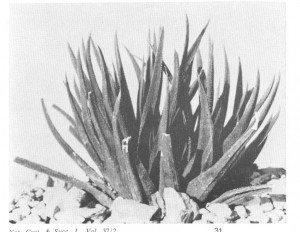
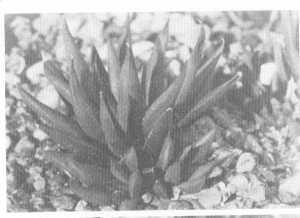
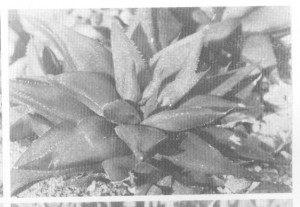
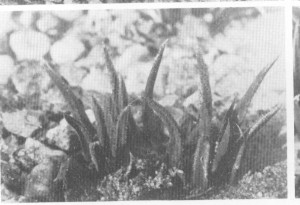
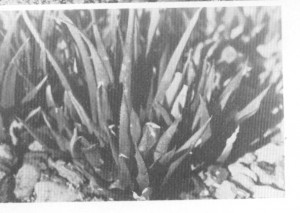
Pingback: Haworthia Revisited - 1. Haworthia angustifolia - Haworthia Updates